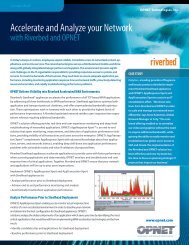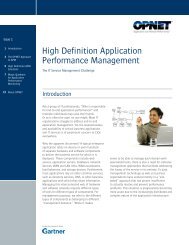Create successful ePaper yourself
Turn your PDF publications into a flip-book with our unique Google optimized e-Paper software.
to distributors are not contingent upon resale of the software to the<br />
end user. In most cases, the Company provides product updates,<br />
technical support and services agreements directly to distributors<br />
and the distributors provide support to the end customer. Revenue<br />
from sales to distributors is recorded at the amounts charged to the<br />
distributor and in the same manner as product, product updates,<br />
technical support and services sales sold through the Company’s<br />
direct sales force. Amounts received in advance of revenue recognition<br />
are classified as deferred revenue.<br />
Sales taxes and other taxes collected from customers and remitted<br />
to governmental authorities are presented on a net basis, and as<br />
such, are excluded from revenues.<br />
allowance for Doubtful accounts. The Company maintains an<br />
allowance for doubtful accounts receivable for estimated losses<br />
resulting from the inability of its customers to make required<br />
payments and for the limited circumstances when the customer<br />
disputes the amounts due the Company. The Company’s methodology<br />
for determining this allowance requires significant estimates.<br />
In estimating the allowance, the Company considers the age of the<br />
receivable, the creditworthiness of the customer, the economic conditions<br />
of the customer’s industry and general economic conditions.<br />
income Taxes. Income taxes are accounted for in accordance with<br />
ASC 740. The income tax provision includes income taxes currently<br />
payable plus the net change during the year in deferred tax assets<br />
or liabilities. Under ASC 740, deferred tax assets and liabilities reflect<br />
the differences between the carrying value under GAAP and the tax<br />
basis of assets and liabilities using enacted statutory tax rates in effect<br />
for the period in which the differences are expected to reverse.<br />
Judgments and estimates are required in the calculation of the<br />
deferred tax assets, valuation allowance, research and development<br />
tax credits, and foreign tax credits.<br />
ASC 740 prescribes a recognition threshold of more-likely-than-not,<br />
and a measurement attribute for all tax positions taken or expected<br />
to be taken on a tax return, in order for these positions to be recognized<br />
in the financial statements. The Company continually reviews<br />
tax laws, regulations and guidance in order to properly record any<br />
uncertain tax positions.<br />
Foreign currency Transactions. Revenue and expenses denominated<br />
in foreign currencies are translated at the average exchange<br />
rates during the period. Gains or losses on foreign exchange transactions<br />
are reported in the consolidated statements of operations.<br />
Foreign currency Translation. The results of operations for the<br />
Company’s international subsidiaries are translated from the designated<br />
functional currencies into United States dollars using average<br />
exchange rates during each period. Assets and liabilities are translated<br />
using exchange rates at the end of each period. Translation<br />
gains and losses are reported as a component of accumulated other<br />
comprehensive loss in stockholders’ equity.<br />
OPNET Technologies, Inc. <strong>2011</strong> <strong>Annual</strong> <strong>Report</strong><br />
37<br />
comprehensive income. Certain revenues, expenses, gains and<br />
losses are recognized in comprehensive income but excluded from<br />
net income. Comprehensive income includes net income, foreign<br />
currency translation adjustments, and unrealized gains and losses<br />
on marketable securities.<br />
Earnings per Share. The Company accounts for earnings per share,<br />
or EPS, in accordance with ASC 260 Earnings per Share, or ASC 260.<br />
ASC 260 states that unvested share-based payment awards that<br />
contain nonforfeitable rights to dividends or dividend equivalents<br />
(whether paid or unpaid) are participating securities and shall be<br />
included in the computation of EPS pursuant to the two-class method.<br />
FSP EITF 03-6-1, “Determining Whether Instruments Granted in<br />
Share-Based Payment Transactions are Participating Securities” (as<br />
codified in ASC 260) is effective for fiscal years beginning after December<br />
15, 2008. The Company applied the provisions of FSP EITF<br />
03-6-1 in fiscal 2010. The Company’s participating securities include<br />
nonvested restricted stock. FSP EITF 03-6-1 was applied retrospectively<br />
and therefore prior period information was adjusted.<br />
Stock-Based compensation. The Company accounts for stockbased<br />
compensation given to employees in accordance with ASC<br />
718 Compensation – Stock Compensation, or ASC 718. ASC 718<br />
requires all share-based payments and nonvested shares (restricted<br />
stock) issued to employees, including grants of employee stock<br />
options, to be valued at fair value on the date of grant, and to be<br />
expensed over the applicable vesting period.<br />
reCenTly issueD aCCounTing pronounCemenTs<br />
In October 2009, the Financial Accounting Standards Board, or FASB,<br />
issued Accounting Standards Update, or ASU 2009-14, “Certain<br />
Revenue Arrangement That Include Software Elements,” (included<br />
in Accounting Standards Codification, or ASC, 985 “Software”) and<br />
ASU, 2009-13, “Multiple Deliverable Revenue Arrangements,” which<br />
amends EITF Issue No. 08-1, “Revenue Arrangements With Multiple<br />
Deliverables” (as codified in ASC 605 “Revenue Recognition”). ASU<br />
2009-14 amends the scoping guidance for software arrangements<br />
to exclude tangible products that contain software elements and<br />
nonsoftware elements that function together to interdependently<br />
deliver the product’s essential functionality. ASU 2009-13 amends<br />
the current guidance on arrangements with multiple elements to (1)<br />
eliminate the separation criterion that requires entities to establish<br />
objective and reliable evidence of fair value for undelivered elements,<br />
(2) establish a selling price hierarchy to help entities allocate<br />
arrangement consideration to the separate units of account, (3)<br />
require the relative selling price allocation method for all arrangements<br />
(i.e., eliminate the residual method), and (4) significantly<br />
expand required disclosures. ASU 2009-14 and ASU 2009-13 will<br />
be effective for the first annual reporting period beginning on or<br />
after June 15, 2010, which the Company adopted on April 1, <strong>2011</strong>.<br />
Early adoption is permitted. The Company has determined that ASU




